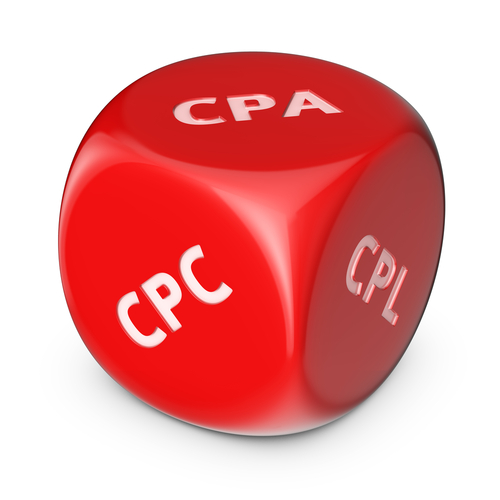What is the Difference Between CPA, CPS, CPL, CPI, CPC, CPM etc.?

For some of us, the acronyms above are incredibly familiar, and something we spend a lot of time on every day. For others, these acronyms leave tons of room for confusion! Allow us to clear up that confusion:
CPA – “Cost per Action” or “Cost per Acquisition”. CPA refers to any campaign where a value is assigned to the acquisition of a lead, sale, subscription, or any predefined “action”. CPA is most commonly used in affiliate marketing when discussing campaigns that are paying for sales.
CPS – “Cost per Sale”. CPS refers to any campaign where an advertiser pays an affiliate for each sale that their traffic produces. If an advertisers’ product sells for $100, they are often willing to pay a large percentage of each sale that an affiliate generates. The thought process behind the CPS model is that there is little to no risk for the advertiser, as they are not paying for leads or clicks to their product. They are only paying a preset value for each sale, and thus do not have to worry about converting leads into sales, or clicks into leads and then those leads into sales. Since quality issues arise fairly infrequently on the CPS model, the main factor determing pay increases for traffic is volume of sales produced.
CPL – “Cost per Lead”. CPL is an affiliate network’s favorite model to work with. When advertisers purchase leads, they are inherently taking a risk that they can offset lead costs with product sales on their backend. For example, an advertiser may purchase leads for $5.00 per lead, and sell their product for $100. In order to break even on their lead costs, they will need 1 sale for every 20 leads. Anything better than a 1:20 ratio becomes profitable for the advertiser. By its nature, buying leads can be very risky business for advertisers. Sometimes, traffic is not very targeted and will produce few or no sales. This is why strict caps are commonly put in place for lead campaigns, so that the advertiser is able to take a maximum risk per publisher in order to test their traffic and see if it works well. The risks associated with buying leads is a great reason why advertisers use affiliate networks. It takes a lot of time to weed through good and bad affiliates, as well as good and bad traffic sources, and years of experience on an affiliate networks end can make the advertisers job very easy. Since purchasing leads is typically performance based, if an affiliate can do strong volume with high quality traffic, the advertiser will pay more for the leads. Using an affiliate network is great for affiliates as the network will negotiate on your behalf, and a network like CPATrend has 6 years experience negotiating the best rates for their affiliates. Additionally, your affiliate network will pay you much quicker than the direct advertiser, thus mitigating your risk as much as possible.
CPC – “Cost per Click”. CPC is another affiliate network favorite, but is higher risk than CPL. With this model, the advertiser is not paying for sales or leads, but they are paying for targeted clicks to their website/product. Advertisers will often use a CPC model when they are very confident in their user flow, retention rate, and ability to close users into paying customers. If they have a very strong close rate, then they can pay more per click. Often times, CPC rates change somewhat frequently throughout the duration of a campaign, as there can be some wild swings in sales (in both the position and negative direction). It is an affiliate network’s job to establish a strong rate that will work for both parties in the long term.
CPI – “Cost per Install”. The CPI model is a very interesting one. It refers primarily to app install offers. The advertiser or app owner will pay the affiliate each time a new user installs an App onto their smart phone, tablet, or sometimes desktop. Often times, the acquisition includes the install, and then the user opening the app for the first time. This model has become gradually more popular as mobile apps have exploded in popularity!
CPM – “Cost per Mille”. The CPM model refers to purchasing impressions. Cost per mille, specifically, refers to the price paid for 1,000 impressions of an ad. CPM is typically used in two ways. CPM is often used is by internet marketers/affiliates purchasing traffic. When they have very strong images/banners/ads, they are likely to produce a high “click-thru rate” (CTR). As such, instead of purchasing traffic on the pricier model of “pay per click”, buying traffic on a CPM basis can produce much more profits. An example of this: If an affiliate pays $0.50 per click, and produces 20 clicks from 1000 impressions, they pay $10.00, since you are only paying for the clicks. If the same affiliate runs the same ad, but on a CPM model, and pays for example, $2.00 CPM, they would effectively be paying only $0.20 per click using the CPM model. So the CPM model, when used appropriately, can get an affiliate a lot more “bang for their buck.”
No matter the model, CPATrend is always looking to provide our affiliates and advertisers with the best deal possible, in a way that serves their interests best.